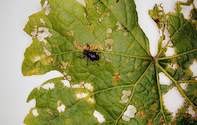Diseases and pests in a vineyard can be divided into different groups namely insects, fungi, bacterial diseases and viruses. The control of diseases and pests is one of the biggest expenses in wine farming and control measures require the producer to use only certain registered sprays.

All spray programs should comply with the requirements of the IPW scheme (Integrated Production of Wine), a voluntary environmental sustainability scheme established by the South African Wine Industry in 1998. This scheme complies with international environmental sustainability criteria and encourages a sustainable approach to pest control.
Producers are advised to use a range of controls that target the pests in different ways, e.g. natural insect predators, parasites (natural enemies), entomopathogenic nematodes (species which kill insects) fungi or bacteria that specifically target the pests. These measures are often used together with chemical pesticides (some of which are organic). The best way to reduce pests and diseases is constant monitoring of the vineyard for symptoms.
The producers increasingly use trained monitors to save costs. These workers are trained to walk through the vineyard on a regular basis and search for the first signs of insects or fungal infection symptoms. With underground pests the symptom is usually poor growth, which occurs in spots in the vineyard block. Vines carry less and shoot growth is poor.
With above-ground pests, the obvious symptoms are holes in leaves, deformed leaves and grape bunches as well as a white waxy infection on the bunches. If there are no obvious symptoms on the leaves, shoots or grape bunches, the viticulturist will dig a hole to look at the roots of the contaminated plants.
During the treatment of the plant with a systemic pesticide, the plant will absorb the drug and kill the fungus or insect from within. If a contact pesticide is used, the plant is covered with a chemical agent and as soon as the insect or fungus tries to damage the plant, it will die.
The Effect of the Climate on Pests
It is also important to know that climate and environment can play a major role in the appearance of diseases and pests. In areas with a low humidity, certain fungal diseases are less known, on the contrary, with high humidity or rain during the growing season, some fungal diseases can be expedited.
The life cycle of insects is usually seasonal and, as in the case of the grapevine mealybug, directly dependent on temperature. Viticulture practices can also play a role in disease and pest control: Good canopy management can reduce fungal diseases. Irrigation should take place when the vineyard is already moist, for example early in the morning.
The row direction and trellising system can also contribute to the improvement of aeration and to dry the leaves sooner after the rain. Weeds provide shelter and a breeding ground for insect pests. The careless use of insecticides can also destroy the natural enemies of pests.
By Vinpro